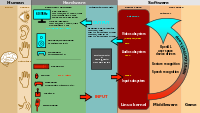
Photo from wikipedia
Invasive alien species are major drivers of global change that can have severe impacts on biodiversity and human well‐being. Management strategies implemented to mitigate these impacts are based on a… Click to show full abstract
Invasive alien species are major drivers of global change that can have severe impacts on biodiversity and human well‐being. Management strategies implemented to mitigate these impacts are based on a hierarchical approach, from prevention of invasion, via early warning and rapid response, to invasive species management. We evaluated how different classes of spatially explicit models have been used as predictive tools to improve the effectiveness of management strategies. A review of literature published between 2000 and 2019 was undertaken to retrieve studies addressing alien mammal species through these models. We collected 62 studies, dealing with 70 (27%) of the 261 mammal species that are considered to be introduced worldwide. Most of the studies dealt with species from the orders Rodentia (34%), Artiodactyla and Carnivora (both 24%); the most commonly studied families were Sciuridae (13%) and Muridae (12%). Most of the studies (73%) provided spatial predictions of potential species spread, while only ca. 15% of the studies included evaluations of management options. About 29% of the studies were considered useful in risk assessment procedures, but only because they presented climatic suitability predictions worldwide, while studies modelling suitability before a species was introduced locally are still lacking for mammals. With some exceptions, spatially explicit population models are still little used, probably because of the perceived need for detailed information on life history parameters. Spatially explicit models have been used in relatively few studies dealing with invasive mammals, and most of them covered a restricted pool of species. Most of the studies used climate matching to evaluate the suitability of geographic areas worldwide or the possibility of species that were already established spreading further. Modelling procedures could be a useful tool to assess the risk of establishment for species not yet present in an area but likely to arrive; however, such studies are lacking for mammals.
Journal Title: Mammal Review
Year Published: 2020
Link to full text (if available)
Share on Social Media: Sign Up to like & get
recommendations!